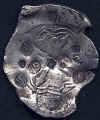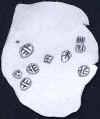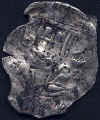Spanish 8 Reale Cob (Philip IV, 1621-1665 ?)
Spanish Colonial Mexico, 8 Reale Cob. N.D.
Based on the partially
visible mintmark on the left of the Hapsburg shield on the obverse of the cob,
this piece was stamped in the Mexico mint. The reverse shows the
distinctive Jerusalem cross with a ball at each extremity which confirms that
the piece was produced at the Mexico mint. The absence of any assayer's
initials or date on the obverse side makes it difficult to date the period of
stamping, but our assumption is that it dates from the period of the Philip IV
(1621-1665).
Weight: 27.8 grams
Chinese chopmarks:
(1) ![]() (Combined
character, in relief, 5-6 mm): 68
(Combined
character, in relief, 5-6 mm): 68
(2) 王 (Wang, in relief, diameter 3-4 mm ): Last name
(3) 凡 (Fang, in intaglio, diameter 4-5 mm): Ordinary
(4) 木 (Mu, by engraving, length 6-7 mm): Wood
(5)  (Symbol,
in relief, 3-4 mm)
(Symbol,
in relief, 3-4 mm)
(6) ![]() (Symbol,
in intaglio, < 2mm)
(Symbol,
in intaglio, < 2mm)
The chop of ![]() ,
that combines two words, i.e.,
,
that combines two words, i.e., ![]() and
and ![]() ,
is stamped on the cob 4 times. Obviously, some one tried to deliver an
important message by repeating the stamp.
,
is stamped on the cob 4 times. Obviously, some one tried to deliver an
important message by repeating the stamp.
![]() and
and ![]() were
both written in the traditional commercial script. Their meanings are
respectively "6" and "8". My belief is that the character combining
these two words was meant to indicate that this cob has a silver content of 6
maces and 8 candareens (6.8 maces or 0.68 tael). This character chop is
therefore an assaying chop.
were
both written in the traditional commercial script. Their meanings are
respectively "6" and "8". My belief is that the character combining
these two words was meant to indicate that this cob has a silver content of 6
maces and 8 candareens (6.8 maces or 0.68 tael). This character chop is
therefore an assaying chop.
The weight of an 8 reale cob was about 7 maces and 2 candareens in the
Chinese weighing system, but because the fineness of a cob was usually lower
than that of the fine silver circulated in China, merchants had to melt it
down and recast it as Chinese sycee. As a result, the value of a cob was
determined by the weight of its silver content, rather than the weight of the
cob.
Given the above, the piece shown, with a weight of 8 reales or 7.2
maces, and a fineness of 94.44%, was recognized by Chinese
merchants as having the same silver content as a sycee of 6.8 maces with the
customary fineness of 100%.
Return to Spanish Colonial Cobs


